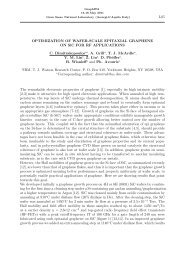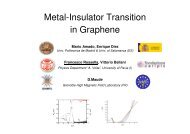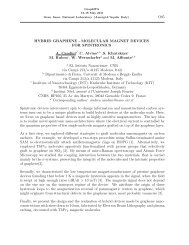Synthesis of stacked graphene sheets by a supersonic ... - GraphITA
Synthesis of stacked graphene sheets by a supersonic ... - GraphITA
Synthesis of stacked graphene sheets by a supersonic ... - GraphITA
Create successful ePaper yourself
Turn your PDF publications into a flip-book with our unique Google optimized e-Paper software.
<strong>Synthesis</strong> <strong>of</strong> <strong>stacked</strong> <strong>graphene</strong> <strong>sheets</strong> <strong>by</strong> a<br />
<strong>supersonic</strong> thermal plasma expansion technique<br />
and the effect <strong>of</strong> sample collection chamber<br />
pressure<br />
Plasma Technology for Waste<br />
Treatment<br />
M. Kakati and N. Aomoa<br />
Thermal Plasma Processed Materials<br />
Laboratory<br />
International Conference on Incineration and<br />
Thermal Treatment <strong>of</strong> Waste<br />
Centre <strong>of</strong> Plasma Physics<br />
May 14, 2007, Phoenix, AZ<br />
Institute<br />
By Pierre Carabin,<br />
for Plasma<br />
M. Eng.<br />
research<br />
Sonapur 782 402, Assam, India<br />
applications through partnership and innovation<br />
<strong>GraphITA</strong> 2011, May 14-18<br />
Gran Sasso National Laboratory, Italy
We are primarily plasma people......<br />
• So here we will mostly<br />
concentrate on those aspects<br />
<strong>of</strong> plasma systems which<br />
may contribute positively in<br />
enhancing material<br />
properties, in this case <strong>of</strong><br />
<strong>graphene</strong> here.<br />
Picture below shows an intense<br />
thermal plasma beam Issuing<br />
from a plasma torch at<br />
Atmospheric pressure<br />
• Undoubtedly, the bulk<br />
production rate is the biggest<br />
advantage <strong>of</strong> thermal plasma<br />
assisted materials synthesis<br />
techniques.
Some other major advantages include….<br />
ü Induces good crystallinity<br />
because <strong>of</strong> the very high<br />
processing temperature.<br />
ü Most <strong>of</strong>ten a single step,<br />
rapid and continuous<br />
process.<br />
ü Clean process, with less<br />
hazardous effluent.<br />
ü Less impurity.<br />
ü A wide variety <strong>of</strong><br />
reactants possible.<br />
TEM photograph <strong>of</strong> highly<br />
crystalline, well dispersed<br />
alumina nanoparticles<br />
synthesized <strong>by</strong> plasma technique
So, what is Plasma <br />
Plasma is an<br />
ionized gas<br />
consisting <strong>of</strong> atoms,<br />
electrons, ions,<br />
molecules,<br />
molecular<br />
fragments, and<br />
electronically<br />
excited species<br />
(informal definition)
The difference between thermal and nonthermal<br />
plasma<br />
§ If T e ≈ T i then we have a<br />
thermal plasma; Plasmas<br />
produced at atmospheric<br />
pressure are mostly this<br />
type.<br />
Non-thermal glow discharge<br />
Plasma being used for<br />
surface engineering<br />
§ If T e » T i then plasma is<br />
non-thermal or nonequilibrium<br />
or cold plasma;<br />
Plasmas produced under<br />
vacuum are mostly nonthermal<br />
plasma.
Two types <strong>of</strong> thermal plasma torches used for<br />
materials processing……<br />
Transferred arc plasma torch<br />
used <strong>by</strong> Munz for synthesis <strong>of</strong><br />
alumina nanoparticles<br />
The non-transferred segmented<br />
torch we used for producing a<br />
<strong>supersonic</strong> plasma beam
The Plasma Expansion Method<br />
The plasma beam is accelerated in to <strong>supersonic</strong><br />
velocity as it is expanded into a low pressure<br />
sample collection chamber while moving through<br />
a converging nozzle.<br />
The nozzle expansion can convert the pressure<br />
and thermal energy into the kinetic energy <strong>of</strong> the<br />
plasma beam. This results in a very high rate<br />
and also uniform cooling.<br />
As opposed to gas mixing cooling, during<br />
expansion the plasma is also accelerated in the<br />
forward direction, which reduces agglomeration.
Advantages <strong>of</strong> the plasma expansion<br />
technique<br />
An intense (10 6 -10 7 K/s) and<br />
also uniform cooling results<br />
in to smaller particles with a<br />
narrow size distribution.<br />
Less particle agglomeration<br />
Several control knobs like<br />
plasma power, reactant<br />
concentration, reactant feed<br />
location and sample<br />
collection chamber pressure.<br />
Physical separation <strong>of</strong><br />
plasma production with<br />
particle growth zone.<br />
Long <strong>supersonic</strong> beam <strong>of</strong>fers<br />
extended residence time at<br />
higher temperature which<br />
enhances crystallinity.
Our experiments on synthesis <strong>of</strong> nanosized<br />
<strong>stacked</strong> <strong>graphene</strong> <strong>sheets</strong><br />
<br />
<br />
<br />
There is active search for<br />
graphitized nanostructured<br />
carbon with typically higher<br />
electrical conductivity combined<br />
with large specific surface area,<br />
to be used as a catalyst in Fuel<br />
Cell applications.<br />
We were using the same<br />
nanoparticle reactor for synthesis<br />
<strong>of</strong> these nano carbons, taking<br />
advantage <strong>of</strong> the extended<br />
residence time in the <strong>supersonic</strong><br />
plasma beam, which is likely to<br />
enhance crystallinity <strong>of</strong> the<br />
material.<br />
Pressure in the sample collection<br />
chamber was used as one <strong>of</strong> the<br />
most important control<br />
parameter.
The Experiments<br />
Control knobs in<br />
the system<br />
§ Plasma Current (150-250 Amperes).<br />
§ Sample Collection Chamber Pressure<br />
(10, 300 and 600 mbar).<br />
§ Location <strong>of</strong> Reactant Injection (hot<br />
zone and Colder Tail Plasma).<br />
§ Catalyst for Better Crystallization<br />
(Ferrocene and Cobaltocene).<br />
§ Carbon Precursors (Acetylene,<br />
Methane and Graphite).<br />
§ Sample collection substrate<br />
temperature.<br />
§ Plasma Gas Flow Rate (10-20 lpm).<br />
§ Number <strong>of</strong> Floating Rings in the<br />
Torch (3-5) Sample Collection Point<br />
(120 and 220 mm).
TEM and XRD characterization <strong>of</strong> the<br />
product<br />
§<br />
§<br />
§<br />
TEM Shows primary<br />
particles <strong>of</strong> less than about<br />
20 nm, fused together<br />
forming branched<br />
aggregates.<br />
Higher magnification<br />
reveals crumpled nano<strong>sheets</strong><br />
<strong>of</strong> carbon inside<br />
these structures.<br />
XRD measures the<br />
interlayer distances (d 002 ) <strong>of</strong><br />
the synthesized carbon to<br />
be in the range <strong>of</strong> 3.42 to<br />
3.47 A 0 (Graphite is 3.36<br />
A 0 ).
BET specific surface area<br />
characterization <strong>of</strong> the product<br />
§<br />
§<br />
§<br />
BET gives specific surface<br />
area <strong>of</strong> the product<br />
(acetylene, 150 ampere<br />
plasma current, 10 mbar<br />
sample collection chamber<br />
pressure) in the range <strong>of</strong><br />
340-360 m 2 /g.<br />
The same sample had a<br />
graphitization <strong>of</strong> 3.47 A 0 .<br />
To our knowledge this is the<br />
best combination <strong>of</strong> both<br />
graphitization (3.47 A 0 ) and<br />
large surface area (340-360<br />
m 2 /g), <strong>by</strong> a plasma assisted<br />
method, most suitable for the<br />
intended applications<br />
We can compare our values (surface<br />
area and graphitization combination)<br />
with some other recent results…<br />
i. 3.46 A 0 /53 m 2 /g and 3.52 A 0 /385<br />
m 2 /g, Kim et al. 2005 IEEE<br />
transaction on plasma science 33(2):<br />
813-823<br />
ii. 4.03 A 0 /30 m 2 /g and 3.55<br />
A 0 /119-345 m 2 /g, Pristavita et al.<br />
2010 Plasma Chemistry Plasma<br />
Processes 30: 267–279<br />
iii. 3.55 A 0 /112-156 m 2 /g, Xiao-Feng et<br />
al. 2010 Plasma Chemistry Plasma<br />
Processes 30: 75-90
Effect <strong>of</strong> sample collection chamber<br />
pressure<br />
• Stacking <strong>of</strong> individual Graphene<br />
<strong>sheets</strong> in a single layer increase with<br />
increasing pressure.<br />
• This may explain the higher specific<br />
surface area (340-360 m 2 /g) <strong>of</strong> our<br />
very low pressure synthesized carbon<br />
nanomaterials.<br />
• Crystallization <strong>of</strong> the material<br />
improves drastically with pressure.<br />
• Crystallization also improves<br />
substantially as the feed material is<br />
injected at a point with higher<br />
temperature. Injecting at the tail had<br />
resulted a graphitization <strong>of</strong> 3.83 A 0.<br />
10 mbar<br />
XRD measured d 002 distances<br />
Pressure in mbar Distance in A°<br />
10 3.47<br />
300 3.42<br />
600 3.41<br />
300 mbar
Effect <strong>of</strong> co-injected metal particles and heated<br />
up particle collecting substrate<br />
• Co-injecting Ferrocene<br />
(Fe(C 5 H 5 ) 2 ) and<br />
depositing on a heated<br />
substrate (350 C) had<br />
improved crystallinity<br />
substantially even at<br />
10-20 mbar pressure in<br />
the sample collection<br />
chamber.<br />
• Some TEM photographs<br />
shows what is<br />
considered to be a single<br />
<strong>graphene</strong> sheet.
Graphene sheet encapsulated iron<br />
nanoparticles<br />
• Another important observation<br />
was formation <strong>of</strong> iron nanoparticles<br />
encapsulated in few <strong>graphene</strong><br />
layers, which have many different<br />
application potential including in<br />
Cancer treatment.<br />
• TEM shows uniform, carbon<br />
capped iron nanoparticles <strong>of</strong> 2-3<br />
nanometers sizes, which is much<br />
smaller compared to any other<br />
thermal plasma assisted method<br />
and only comparable to laser<br />
assisted techniques.
Thank You!






